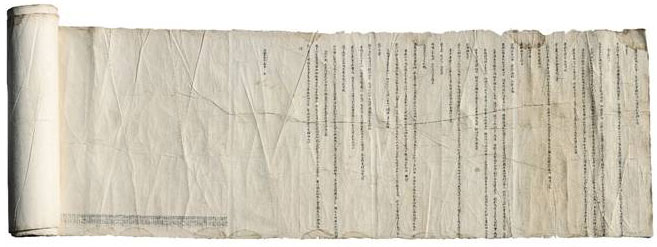E-mail : master@koreastudy.or.kr
Tel : 82-54-851-0700
The Advanced Center for Korean
Studies copyright ©2017
Ten Thousand People’s Petition against Dress Reform (1884)

Number of Signers : 8,849 width : 1.02m Height : 100.36m weight : 8.3kg
Maninso, or the petition of 10,000 persons was written to oppose the dress modernization policies of the Joseon Dynasty. In the leap month of May, 1884(in lunar calendar, all dates in this paper are in lunar calendar), the Joseon government in the name of enlightenment, implemented the garment renovation to force people to wear narrow sleeve clothes. The intellectuals of Joseon including government ministers considered this government measure to be an action to destroy the tradition of Joseon, and objected to it vehemently. Many sangsoes, or petitions by Yusaeng, or Confucian scholars were filed against it from every corner of the nation. Among them was this Maninso. It is one of the few maninsoes existing until today.
This Maninso was written in October, 1884 (21st year of Gojong’s reign). Exactly, a total of 8,849 persons signed it, and Sodu (疏頭), or the leader was Jae-gyo Lee (李在嶠: 1822∼1890) whose literary name was naegok (內谷). He was a descendant of Eon-jeok Lee (李彦迪) whose literary name was Hoejae (晦齋). As the yusaeng of Gyeongju took the lead, and the descendant of heojae participated as the leader, the original maninso is kept in Oksan Seowon, or Oksan Confucian Academy in Gyeongju. The size of the maninso is very big, with the height of 102㎝ and the width of 10,036㎝. Considering the number of people who signed the petition and the size of it, we understand that it took a significant time and money to make it. However, it was not filed because at the time of completion, the Gapsin Coup occurred and the dress modernization measure itself was cancelled.
Though it was not filed, this petition contained various information. At the end of the Joseon dynasty, in the transition period from a traditional society to a modern one, it had the perception and the response of the intellectuals to the times. The ‘dress reformation-opposing maninso’ was the embodiment of the efforts of the Joseon’s traditional intellectuals to stop the reality in which Joseon was running toward ‘enlightenment.’ In the maninso, there are three main historical facts. The first is Joseon’s ‘politics of public opinion’ tradition. The second is the pro-Confucianism, anti-Westernization ‘WijongChoksa’ movement. The last is the ‘dress reformation’ which caused the maninso petition. The WijongChoksa way of thought represents the pride in our culture and our nation’s traditional clothing. The “dress reformation” meant not only westernizing our daily clothes, but also giving up on our culture and pride. Therefore, the traditional intelligentsia expressed a fierce opposition to it. The dress reformation, which was first implemented in the leap month of May, 1884, was met with strong opposition from bureaucrats including government ministers and yusaeng. To make matters worse, a coup occurred, thwarting the reformation attempt. However, in 1895, as part of the Gabo Reform, not just the clothing reformation but also the ordinance prohibiting topknots (the Short Hair Act) were enforced, sending the opposition to extremes and leading to the fighting of the righteous armies.
The detailed background and the process of this Maninso are well documented in Eulmyosocheongilgi and Sohaengilrok donated to Advanced Center for Korean Studies.
In January 1855, people at Byeongsan Seowon (屛山書院) and Hogye Seowon (虎溪書院) in Andong heard about adding another Jonho for the Crown Prince Jangheon for the first time since Jeongjo. Therefore, they suggested to hold a gathering (儒會) at Dosan Seowon. Dosan Seowon agreed and participated in the two other Seowon’s suggestion and decided to hold a meeting to discuss about Sangso to reinstate the status of Sado and to change to the king. Then, they notified Andongbu (安東府). About 90 Yusaeng gathered at Dosan Seowon on January 27th and Sogye (素溪) Yi Hui-byeong (李彙炳) was selected as the leader. He was the descendant of Teogye Yi Hwang and the son of Hyeongam Yi Yi-sun (李頤淳). His brother, Yi Man-hee (李晩憙) was adopted as the succeeding grandson of Teogye as well. Yi Hui-byeong’s family was acting like a center in the Jinseong Yi clan of Ye-an.
Therefore, in order to understand the “dress reformation-opposing maninso” deeply, we need to discuss these three historical facts. We will examine first the public opinion-based politics of Joseon, then the WijongChoksa movement, and lastly the dress reformation in chronological order.

